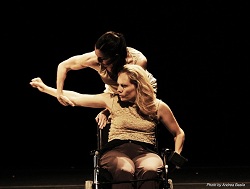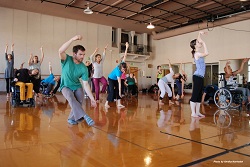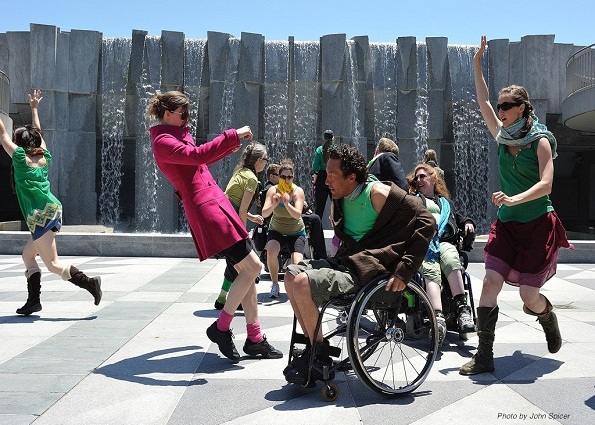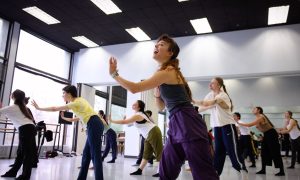By Emily Yewell Volin.
Judith Smith, Artistic Director of AXIS Dance Company, obviously enjoys her job. “We get to do art, but it’s art that has an impact,” she says. “If every time you go to work somebody tells you that you are mind-blowing and inspiring, it’s really gratifying. We get to do great work and work with really fabulous choreographers.”
Dance Informa spoke with Judith Smith to find out more about the physically-integrated contemporary dance company and why AXIS makes such an impact.
How did AXIS Dance Company get started?
Our first director, Thais Mazur, was a dancer who was bored with what she was doing and seeing in dance. She started working with a theater group of disabled adults and she thought, ‘if we can do it with theater, why not with dance?’ She started out just doing a workshop of lighting and movement and it was out of that workshop that the idea to do a dance piece came. More people got together and some of us were movers and some of us weren’t. We all got really hooked on the innovation, the experimentation, the exploration and really discovering something new. We got together with the idea of doing one piece but the dance community got really excited about what we were doing, and the disability community did too. It just kind of snowballed. Before we knew it we were rehearsing regularly and performing a fair amount.

AXIS Dance Company Dancers Judith Smith & Janet Das. Photo by Andrea Basile
Describe how AXIS Dance utilizes contact improvisation in creating work.
Contact improvisation has a huge place in the history of physically-integrated dance. When we started AXIS we didn’t know people setting choreography, but we knew contact improv was happening between people with and without disabilities. We used contact improv a lot early on and we still use it. It’s a great way for people who are coming to dance, especially disabled people without a huge dance background, to learn about their own movement vocabulary, and a great way to develop partnering with other people.
Do you find choreographers get particularly excited about creating for AXIS Dance Company?
Instead of having disabled dancers being a limitation, it’s a huge opportunity to create movement that can’t be created otherwise. The way wheelchairs move is beautiful and there’s a fluidity that happens. I think when choreographers come in two things happen – they are often intimidated because it is such a new and different way of moving and looking at movement. And they are excited. The possibilities for movement are radically expanded.
What have you learned as Artistic Director of the company since 1997?
What I’ve found is that choreographers don’t work with us that differently than they work with their own company or another company that commissions them. What has been really gratifying is that everyone who comes in to teach a master class or set a piece on us leaves feeling like they got something out of it too. They got pushed in different directions or worked in ways that they maybe hadn’t had the opportunity to do with their own company. I feel we get really strong works from people because it excites them.
You came to dance five years after your neck was broken in a car accident. What have you gained through your study of movement?
I’ve gained so much physical strength, coordination and balance through doing improvisational movement, martial arts and dance that I never got in rehab. When you are dancing and exploring it opens up channels of movement you don’t find during traditional rehab. Traditional rehab is really important and I went to a really great rehabilitation hospital. But, all the things that I have learned that really impacted my level of independence were learned through dance and movement, not through rehab.

AXIS Physically Integrated Summer Intensive. Photo by Annika Nonhebel
Does AXIS Dance Company also run educational programs?
About 50% of our time is spent doing educational work. We have an in-studio program for kids, teens and adults. We teach classes and workshops in the community. We have an extensive assembly program and perform for about 15,000 kids a year in schools. We also bring them into our theater for what we call Dance Access Day. It’s a free event.
We do in-school residencies and have a really great relationship with one of the school districts whose adaptive PE teacher has worked with us for a long time. She has a model that we’ve taken on called ‘Peer Pals’, in which we have non-disabled students come and work with disabled students in the schools. It’s a really great way to integrate into the community and build bridges.
We also love university work and performing arts high school venues, and we do corporate work. Our work is such a great format for talking about diversity, inclusion, collaboration and human potential and possibility.
Do you run summer intensives?
Yes. It’s very difficult for disabled dancers to get training in dance and it’s also very difficult for non-disabled dancers who want to work in physically integrated dance to find places to go do that. We’ve done 7 or 8 summer intensives and they are always internationally attended.
If you could have a single wish come true for AXIS Dance this new year, what would that wish be and why?
I wish we had more financial backing, especially from individuals. That would allow us to take some risks and to establish some deeper connections internationally and nationally. I really want another international festival to happen, like the festival we were able to help get together in Boston in 1997. We had 14 companies there. It’s such a wonderful way to cross pollinate. We also need to be at wheelchair ballroom conferences, disability sports events, disabled children’s camps, and dance conferences. We just don’t have the money to be everywhere we want to be.
Top photo: AXIS Dance Company and Community Dancers in the Yerba Buena Gardens Festival. Photo by John Spicer















